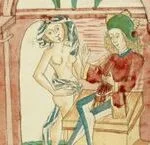Berliners Are Rediscovering Their Faith Outdoors Through Local Pilgrimages
A small group of walkers—many of them retirees bundled in wool hats and fleece jackets—assembled in a quiet circle deep in the Grunewald forest just beyond Berlin’s city limits. Participants were invited to “walk silently through nature and notice what you observe,” as directed by Stephen Lemke, an adviser for senior citizens with the local evangelical church. In his introductory meditation, Lemke encouraged the group to savor every detail of their surroundings: “I hear the sound of the wind. I feel the sun on my skin. I enjoy the moment. But at the same time, I realize that this moment cannot be captured.” After this quiet reflection, the group embarked on an hour-long walk in silence.
Across Berlin, organized Christian pilgrimage walks are taking place nearly every week. These journeys, led by pastors with a passion for the outdoors or done in a self-guided manner with visits to churches and other sacred sites, are gaining traction among both locals and visitors. Some pilgrimages last just an hour, while others span multiple weeks, offering a nontraditional space for people of all ages to engage with faith and community without having to step inside a church building.
Reviving a Historic Tradition for a Modern Age
Pilgrimages have seen a resurgence in recent decades in Europe, particularly in southern Germany, as individuals in an increasingly secular and aging society look to reconnect with their Christian heritage. Nicolas Budde, a pilgrim pastor in Berlin’s Kladow borough, observes, “A lot of people won’t go to church anymore, but they still are religious. The church has to find new ways to discuss religion with people, and pilgrimage is one part of that conversation.”
Historically, pilgrimages were rigorous journeys. In the 1500s, devout Catholics undertook long treks to visit sacred relics such as those at Santiago de Compostela in Spain. These expeditions were acts of devotion meant to demonstrate one’s faith and to seek spiritual cleansing. However, by 1520, reformer Martin Luther denounced the practice. He argued that pilgrimages were unsupported by Scripture and laden with the greed and commercialism he saw as corrupting the church. For Luther, the divine presence was not confined to a specific location, and the need for organized pilgrimages quickly diminished.
Bettina Kammer, a public relations officer with the Protestant church in Spandau, explains that while medieval pilgrimages were outward demonstrations aimed at gaining divine favor, their modern counterparts tend to be more personal. “Today, people feel they are searching for something they can’t quite name,” she noted.
Films, Routes, and Personal Transformations
The renewed interest in pilgrimage has also been spurred by films that explore the spiritual journey, such as a popular German movie from 2015 and another well-known film from 2010 that follows the Camino de Santiago. In 2020, the suburb of Spandau in Berlin introduced a 75-kilometer loop inspired by the Camino de Santiago. This route, which connects a mix of Protestant and Catholic churches, is designed for walking, biking, or canoeing, with pilgrims collecting stamps at each church along the way.
For many, a pilgrimage becomes a catalyst for deeply personal spiritual experiences. Kammer explains, “It often starts with a simple walk and eventually leads to moments of quiet reflection inside a church—a truly moving religious experience.” Budde adds that while the physical act of walking can be simple, a pilgrimage is an internal journey: “You may travel on foot, but you make a pilgrimage with your heart.”
Thomas N.H. Knoll, who manages the St. Jacobi Pilgrimage Center’s information office in Berlin, emphasizes that these journeys can provide both physical and emotional strength during challenging times, such as the loss of a loved one, illness, or other personal struggles. Moreover, disconnecting from everyday distractions—like leaving a phone behind—can foster a deeper connection with nature and, in turn, the divine.
Building Community and Renewing Faith
In addition to personal enrichment, pilgrimages offer a valuable opportunity for building new friendships. They serve as a gathering for seniors who might otherwise feel isolated and for young people who yearn for a connection to their faith outside the traditional church setting. For instance, Alexander Steinfeldt founded a group specifically for young Berliners interested in hiking and exploring philosophical and spiritual themes after experiencing his own disconnect from community and religion.
These pilgrimages typically begin with a prayer and continue with moments of reflection along the way. One participant described noticing subtle changes in the environment—a hint of spring in budding trees, the sound of birds, and a gentle warming breeze—while another looked forward to the comfort of a warm cup of coffee after the walk. By journey’s end, participants, some nearing 90, often find that they have forged new connections and felt a quiet, personal encounter with God.
Concluding one silent pilgrimage, Stephen Lemke offered a heartfelt prayer: “Stand in the sun and feel its warmth. May the Lord be with you, like the ground that carries you, like the air you breathe, like the bread that sustains you, and like the sun that brightens your day.” Such moments, Lemke says, have prompted many to rediscover prayer after years of absence, marking even the smallest step on the path back to faith.

Rockin’ the faith, one verse at a time!
Growing up, the Bible’s stories deeply impacted me. Now, with over 15 years of preaching experience, I blend timeless teachings with modern technology, making them relevant for today’s world.
Bible Hub Verse is my platform to share historical insights and thought-provoking articles, exploring both familiar and uncommon Christian topics. My passion is building a welcoming online space for everyone to learn, grow in their faith, and discover the Bible’s enduring message.
Join the journey!
God bless you.






